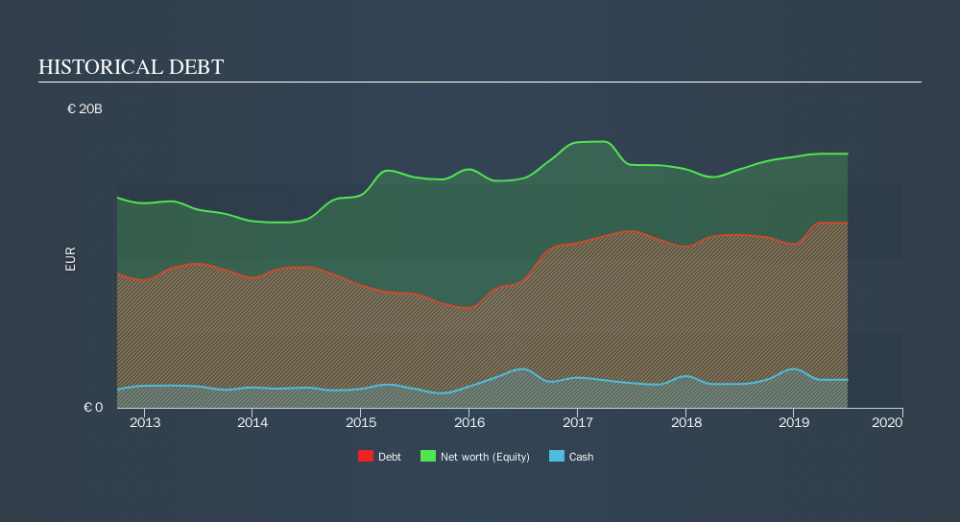These 4 Measures Indicate That HeidelbergCement (FRA:HEI) Is Using Debt Extensively

Howard Marks put it nicely when he said that, rather than worrying about share price volatility, 'The possibility of permanent loss is the risk I worry about... and every practical investor I know worries about.' When we think about how risky a company is, we always like to look at its use of debt, since debt overload can lead to ruin. We can see that HeidelbergCement AG (FRA:HEI) does use debt in its business. But should shareholders be worried about its use of debt?
What Risk Does Debt Bring?
Generally speaking, debt only becomes a real problem when a company can't easily pay it off, either by raising capital or with its own cash flow. In the worst case scenario, a company can go bankrupt if it cannot pay its creditors. However, a more common (but still painful) scenario is that it has to raise new equity capital at a low price, thus permanently diluting shareholders. Having said that, the most common situation is where a company manages its debt reasonably well - and to its own advantage. The first step when considering a company's debt levels is to consider its cash and debt together.
View our latest analysis for HeidelbergCement
What Is HeidelbergCement's Debt?
The image below, which you can click on for greater detail, shows that at June 2019 HeidelbergCement had debt of €12.4b, up from €11.6b in one year. However, because it has a cash reserve of €1.88b, its net debt is less, at about €10.5b.
How Healthy Is HeidelbergCement's Balance Sheet?
The latest balance sheet data shows that HeidelbergCement had liabilities of €7.79b due within a year, and liabilities of €12.2b falling due after that. Offsetting this, it had €1.88b in cash and €3.24b in receivables that were due within 12 months. So its liabilities outweigh the sum of its cash and (near-term) receivables by €14.9b.
When you consider that this deficiency exceeds the company's huge €13.2b market capitalization, you might well be inclined to review the balance sheet, just like one might study a new partner's social media. Hypothetically, extremely heavy dilution would be required if the company were forced to pay down its liabilities by raising capital at the current share price.
We use two main ratios to inform us about debt levels relative to earnings. The first is net debt divided by earnings before interest, tax, depreciation, and amortization (EBITDA), while the second is how many times its earnings before interest and tax (EBIT) covers its interest expense (or its interest cover, for short). The advantage of this approach is that we take into account both the absolute quantum of debt (with net debt to EBITDA) and the actual interest expenses associated with that debt (with its interest cover ratio).
HeidelbergCement has a debt to EBITDA ratio of 3.6 and its EBIT covered its interest expense 6.2 times. This suggests that while the debt levels are significant, we'd stop short of calling them problematic. HeidelbergCement grew its EBIT by 5.1% in the last year. Whilst that hardly knocks our socks off it is a positive when it comes to debt. The balance sheet is clearly the area to focus on when you are analysing debt. But it is future earnings, more than anything, that will determine HeidelbergCement's ability to maintain a healthy balance sheet going forward. So if you're focused on the future you can check out this free report showing analyst profit forecasts.
Finally, a business needs free cash flow to pay off debt; accounting profits just don't cut it. So the logical step is to look at the proportion of that EBIT that is matched by actual free cash flow. Looking at the most recent three years, HeidelbergCement recorded free cash flow of 48% of its EBIT, which is weaker than we'd expect. That's not great, when it comes to paying down debt.
Our View
To be frank both HeidelbergCement's net debt to EBITDA and its track record of staying on top of its total liabilities make us rather uncomfortable with its debt levels. Having said that, its ability to grow its EBIT isn't such a worry. Looking at the balance sheet and taking into account all these factors, we do believe that debt is making HeidelbergCement stock a bit risky. That's not necessarily a bad thing, but we'd generally feel more comfortable with less leverage. Another positive for shareholders is that it pays dividends. So if you like receiving those dividend payments, check HeidelbergCement's dividend history, without delay!
Of course, if you're the type of investor who prefers buying stocks without the burden of debt, then don't hesitate to discover our exclusive list of net cash growth stocks, today.
We aim to bring you long-term focused research analysis driven by fundamental data. Note that our analysis may not factor in the latest price-sensitive company announcements or qualitative material.
If you spot an error that warrants correction, please contact the editor at editorial-team@simplywallst.com. This article by Simply Wall St is general in nature. It does not constitute a recommendation to buy or sell any stock, and does not take account of your objectives, or your financial situation. Simply Wall St has no position in the stocks mentioned. Thank you for reading.

 Yahoo Finance
Yahoo Finance 
